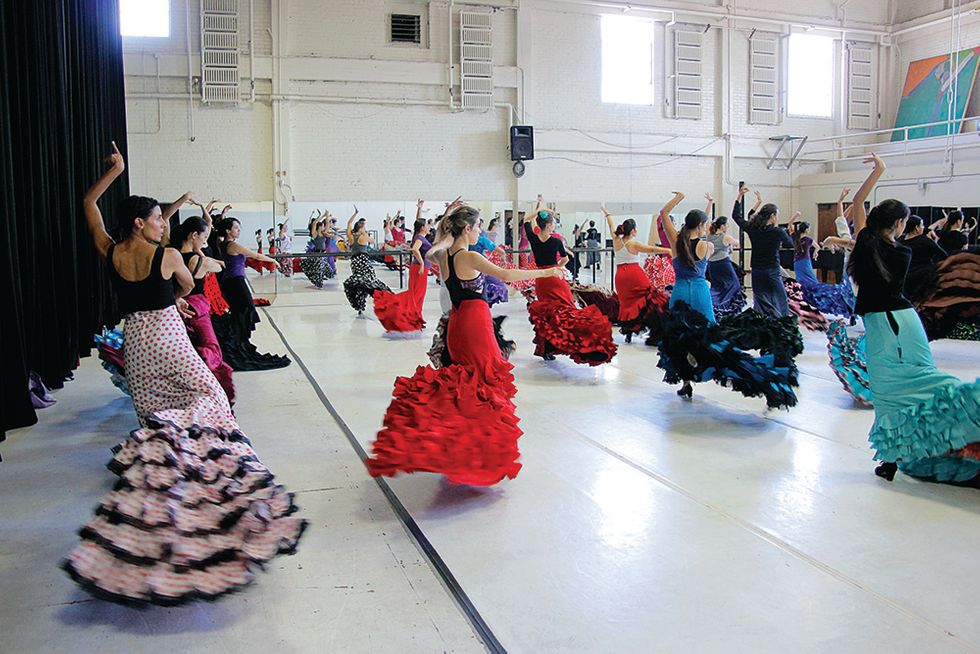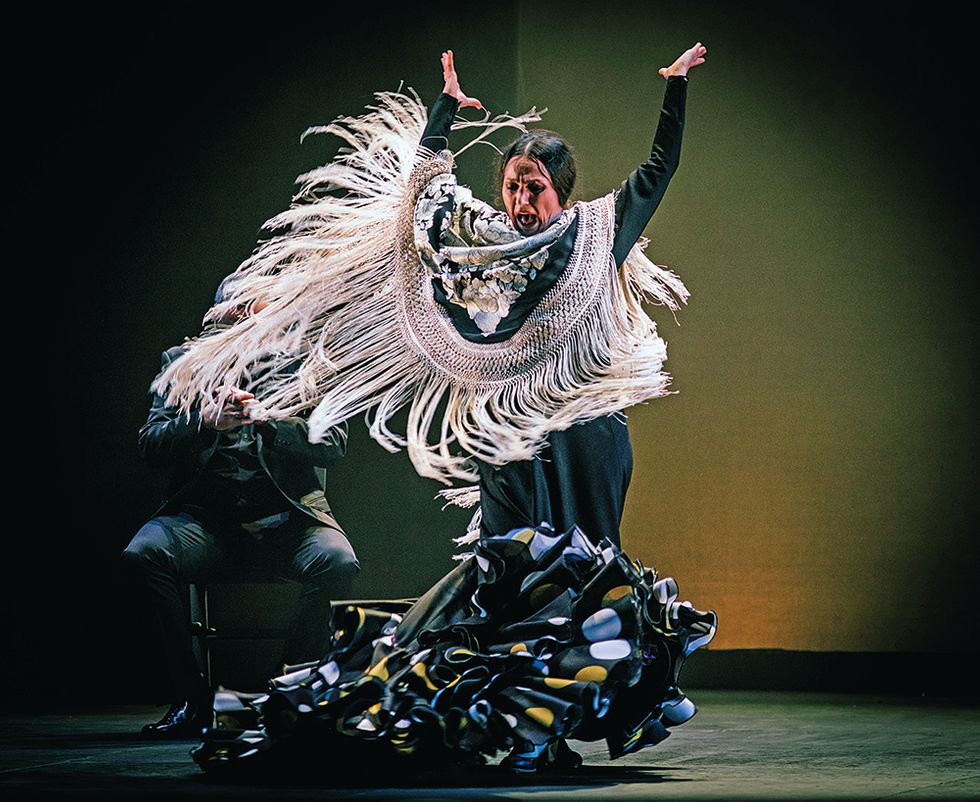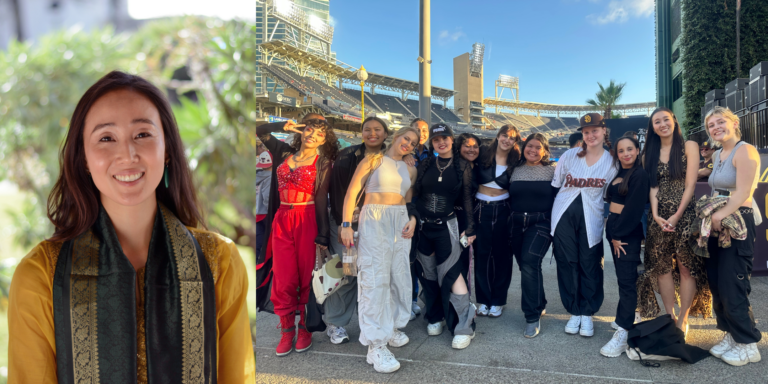
A fierce concentration fills the studio as a group of flamenco students—male and female, undergraduate and graduate—rehearse under the watchful gaze of Daniel Doña and Cristian Martín. The young men stretch their bodies in taut, elegant lines. The young women move their arms in fluid contrast to the brisk, rhythmic staccato of their feet. Long, ruffled skirts, called batas de cola, are draped carefully over the audience seats for the women to wear during sections that involve manipulating them like dramatic mermaid tails. When the passage is finished, Doña gives corrections about spacing, while Martín quietly takes one of the men aside to demonstrate how to perform an airborne renversé-esque move with more attack. Martín’s legs slice swiftly like a blade, yet it takes a magically long time for him to land from the jump.
Celebrated Spanish flamenco artists, Doña and Martín are in residence at the University of New Mexico in Albuquerque. The city has become home to the most vibrant flamenco community outside of Spain as flamenco itself has become increasingly popular in the U.S. Festival Flamenco Albuquerque, which takes place every June, draws leading international flamenco artists, and UNM offers the only accredited flamenco concentration in the country. Yet as flamenco evolves beyond its traditional roots, the concentration has become an incubator as well as a wellspring of dance excellence.
UNM’s dance program offers staples such as ballet and modern technique classes, kinesiology and dance writing, but by their junior year, undergraduate dance majors must choose between a contemporary or a flamenco concentration. Flamenco students will then take classes in the history, structure, improvisational forms, techniques and choreography of their chosen pursuit.
There are currently 25 undergraduates pursuing a BA within the flamenco concentration. “These numbers have grown substantially in the past five years,” says Donna Jewell, chair of the UNM dance and theater department. “We have tripled the number of students auditioning to be in the flamenco concentration. We also are attracting more MFA graduate students interested in the flamenco discipline.”
Two of the program’s biggest draws are Eva Encinias-Sandoval, a leading flamenco artist who launched the festival 32 years ago and has taught flamenco at the university for 45 years, and her daughter Marisol Encinias, who currently directs the UNM flamenco concentration as well as the festival. Like the UNM flamenco program, the festival has grown. As its budget has increased, it has allowed Encinias to bring more artists each year—from traditional Gypsy family troupes to performers like Doña who push the boundaries of how flamenco is understood, incorporating other forms such as classical Spanish dance and folklórico. The festival now includes performances, classes, history colloquia and workshops—most taking place at the university.
Many of the artists who perform in the festival also hold choreography residencies for the flamenco concentration during the academic year, working with the students for weeks, teaching technique and setting works. The resident-artist program is separate from the festival. “I always try to bring people who will teach,” says Encinias. “As well as artistry, expression and musicality, I want the students to work with dancers who will be very clear in how they interpret technique.”
The Encinias family’s artistic influences feel like a microcosm of both flamenco and New Mexico culture. The state’s history is old, diverse and sometimes challenging to reckon as Spanish, Native American, Mexican and U.S. cultures clashed and blended. “My grandmother was a dancer and singer. Her mother was a singer of traditional New Mexican music,” says Encinias. “My mother would do flamenco, Spanish classical dance, ballet—it was all-encompassing. I grew up dancing with my family. There was no distinction, no ‘Now my mother is dancing modern’ and ‘Now she’s doing flamenco.’ My mother loves dancing. To me, that is important.” This perspective has helped Encinias establish a broad and celebratory view of flamenco in both the UNM program and the festival.
The festival exposes the students to a level of flamenco rarely seen outside of Spain, both in formal performances and in postperformance tablao, an informal flamenco setting, like a tavern, where flamenco is improvised communally. “The festival has been one of the peak experiences of my life,” says Samantha Martinez, a fourth-year undergraduate double-majoring in flamenco and psychology. “All of the top flamenco artists are here under our roof. As students, we do work-study to pay for classes and tickets. All of us—these amazing dancers and the students—are with each other all week long. We’re taking classes all day, seeing shows every evening and ending each night at the tablao for seven days. You get to know the artists from all around the world and see what drives them.”
Many of the performers at the festival challenge the idea of what flamenco can be. Israel Galván, for one, comes from a long line of traditional flamenco dancers. Yet he creates stunningly innovative works that both tap and expand traditional flamenco, including a collaboration with Akram Khan set to Gregorian chants and a flamenco interpretation of Kafka’s Metamorphosis. Some of Galván’s pieces have raised questions among traditionalists about how far the artform’s limits can be pushed.
This push and pull between tradition and freedom is a pervasive theme in discussions about flamenco, and not merely in academic settings. In Spain, there are skeptics as to whether non-Spaniards or even non-Gypsy Spanish dancers can perform flamenco. Encinias, however, takes a different view. “It’s like saying Misty Copeland can’t do ballet,” she says. “That idea is alive and well in Spain among certain people. But there are amazing dancers doing flamenco everywhere now.”
Third-year MFA student Justice Miles is studying choreography and has focused on flamenco as her path to self-expression. She has created a contemporary dance to flamenco music, constraining the choreography to the rhythms and patterns of flamenco dance. “I’m a choreography major, and I am an African-American and Norwegian-American young woman,” she says. “I always felt racially and stylistically in-between. I view myself as an intermediary between people and different cultures. My work puts these into conversation.”
Encinias wants the program’s students to grapple with the conflict between tradition and exploration. “There is a struggle for power, authenticity, the right to be able to do flamenco,” she says. “People are challenging everything within this artform—gender roles, norms, prescribed ways of being. It’s perfect that we can study flamenco in a university setting, because this is the place where students are supposed to think about these historical and political issues. It’s important for my students to understand the tensions implicit in the artform and to understand how this challenges them as dancers and people. Flamenco can be such a powerful learning tool when you challenge yourself not to look at it superficially.”

Workshop with batas de cola—the flamenco long-tailed skirt. Courtesy of National Institute of Flamenco




